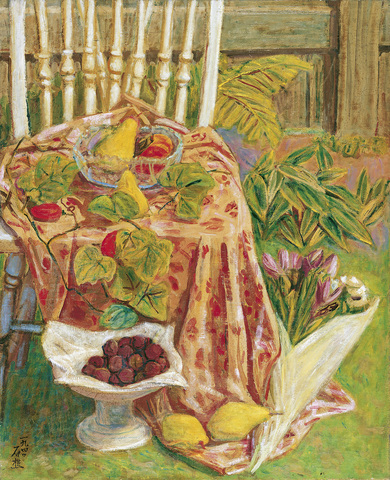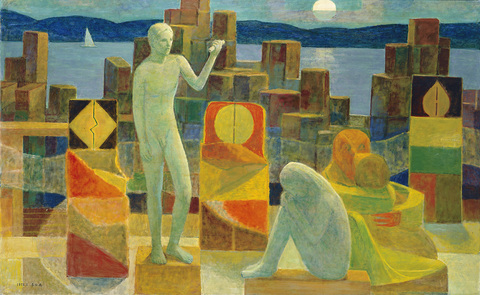Three of Li Shih-chiao's (李石樵) paintings adorn the walls of the Presidential Office, which is a testament to the respect he earned in his lifetime. To celebrate the one-hundredth anniversary of the artist's birth, the Taipei Fine Arts Museum (TFAM) will hold a retrospective of his work beginning Feb. 16.
The curators at TFAM arranged the exhibit to chart Li's development as an artist, bringing together paintings that span his long career and provide a context to show the influence he had on later generations of artists.
"You have to be determined, and willing to bear hardship," Li once remarked. "My whole life, I've seriously pursued one thing: how to paint my paintings well."

PHOTOS COURTESY OF TFAM
The exhibit, which reveals Li's interest in Western and Eastern artistic styles, is arranged chronologically in three sections titled refinement, metamorphosis and light.
Early in his career, Li studied under the Japanese masters Ishikawa Kinichiro and Yoshimura Yoshimatsu, painting the people and scenery of Taiwan with sparse brush strokes and solid, brilliant colors.
The first section includes paintings from the late 1920s and early 1930s, when Li was refining his style at the prestigious Tokyo School of Art. During this period he adhered to a form of realism and French Impressionism that found expression in portraits and landscapes from Taiwan, though a number of his works have Japanese subjects.

The painting Still Life, exemplifies Li's mastery of line and form, with firm brushwork and radiant colors.
At the end of World War II, earlier artistic styles went out of fashion as an influx of traditional Chinese ink painters arrived when Chiang Kai-shek (蔣介石) and the Chinese Nationalist Party forces fled China. Unperturbed by the political atmosphere, Li explored and experimented with styles from the West, discarding the realist movement of his earlier years and immersing himself in Cubism, Expressionism, Surrealism and Symbolism.
Li's adoption of these artistic styles fueled his creation of a novel series of paintings. Still Life Flowers, painted in 1961, is rich in symbolism and far removed from earlier works, which emphasized realism.
The third and final period of Li's output, from the early 1970s until he put the brush down twenty years later, is marked by a preoccupation with light, exemplified by his Three Graces.
It is also during this period that Li threw in his lot with a younger generation of painters who, due to the growing affluence of Taiwanese society and the consequent access to other parts of the world, focused on using art to represent the expression of ideas.
As part of the exhibition, TFAM is including related manuscripts and documents from each period to provide a context to Li's works.

In the March 9 edition of the Taipei Times a piece by Ninon Godefroy ran with the headine “The quiet, gentle rhythm of Taiwan.” It started with the line “Taiwan is a small, humble place. There is no Eiffel Tower, no pyramids — no singular attraction that draws the world’s attention.” I laughed out loud at that. This was out of no disrespect for the author or the piece, which made some interesting analogies and good points about how both Din Tai Fung’s and Taiwan Semiconductor Manufacturing Co’s (TSMC, 台積電) meticulous attention to detail and quality are not quite up to

It is one of the more remarkable facts of Taiwan history that it was never occupied or claimed by any of the numerous kingdoms of southern China — Han or otherwise — that lay just across the water from it. None of their brilliant ministers ever discovered that Taiwan was a “core interest” of the state whose annexation was “inevitable.” As Paul Kua notes in an excellent monograph laying out how the Portuguese gave Taiwan the name “Formosa,” the first Europeans to express an interest in occupying Taiwan were the Spanish. Tonio Andrade in his seminal work, How Taiwan Became Chinese,

Mongolian influencer Anudari Daarya looks effortlessly glamorous and carefree in her social media posts — but the classically trained pianist’s road to acceptance as a transgender artist has been anything but easy. She is one of a growing number of Mongolian LGBTQ youth challenging stereotypes and fighting for acceptance through media representation in the socially conservative country. LGBTQ Mongolians often hide their identities from their employers and colleagues for fear of discrimination, with a survey by the non-profit LGBT Centre Mongolia showing that only 20 percent of people felt comfortable coming out at work. Daarya, 25, said she has faced discrimination since she

April 21 to April 27 Hsieh Er’s (謝娥) political fortunes were rising fast after she got out of jail and joined the Chinese Nationalist Party (KMT) in December 1945. Not only did she hold key positions in various committees, she was elected the only woman on the Taipei City Council and headed to Nanjing in 1946 as the sole Taiwanese female representative to the National Constituent Assembly. With the support of first lady Soong May-ling (宋美齡), she started the Taipei Women’s Association and Taiwan Provincial Women’s Association, where she